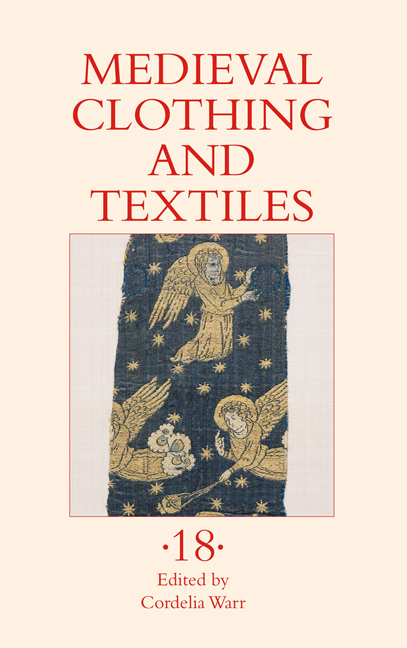Book contents
- Frontmatter
- Contents
- Illustrations
- Tables
- Contributors
- Preface
- 1 Linen Armour in the Frankish Countries: The Twelfth Century
- 2 Serial Production and Individualisation in Late Medieval Silk Weaving
- 3 The Trousseau of Isabella Bruce, Queen of Norway (The National Archives, Kew, DL 25/83)
- 4 Make and Create: The Craftswomen in the Salone Frescoes of the Palazzo della Ragione, Padua
- 5 Combs, Mirrors, and Other Female Beauty Bling in the Later Middle Ages
- 6 The Dividing Lines of Social Status in Sixteenth-Century Scottish Fashion
- Recent Books of Interest
- Author Index, Volumes 1–17
6 - The Dividing Lines of Social Status in Sixteenth-Century Scottish Fashion
Published online by Cambridge University Press: 10 May 2024
- Frontmatter
- Contents
- Illustrations
- Tables
- Contributors
- Preface
- 1 Linen Armour in the Frankish Countries: The Twelfth Century
- 2 Serial Production and Individualisation in Late Medieval Silk Weaving
- 3 The Trousseau of Isabella Bruce, Queen of Norway (The National Archives, Kew, DL 25/83)
- 4 Make and Create: The Craftswomen in the Salone Frescoes of the Palazzo della Ragione, Padua
- 5 Combs, Mirrors, and Other Female Beauty Bling in the Later Middle Ages
- 6 The Dividing Lines of Social Status in Sixteenth-Century Scottish Fashion
- Recent Books of Interest
- Author Index, Volumes 1–17
Summary
The extant accounts of expenditure from the royal treasury in mid-sixteenth-century Scotland represent a gold mine of information on many topics. Purchases of finished clothing items, fabric for clothing, and dress accessories appear mingled among others, although they are usually found in sections with titles such as “The expensis debursit upoun my Lorde Governour, his Ladye, and bairnis awyn personnes” or “The expensis debursit be my lord governoris precept and spetiall commande.” The Lord Governor was James Hamilton, Earl of Arran and regent for Mary, Queen of Scots, between 1543 and 1554. This article is based on an analysis of records of clothing, fabric, and accessory purchases extracted from the accounts of royal treasury expenditure during his tenure, collated according to recipients.
Amongst the accounts lies the key to deciphering how certain types of clothing and fabric represented layers of social status and the dividing lines between them. Although the accounts provide fascinating individual wardrobe biographies, which I discuss in Dressing the Scottish Court, 1543–1553: Clothing in the Accounts of the Lord High Treasurer of Scotland, broader analysis also yields interesting results, including which groups of people commonly wore certain garments and fabrics and the importance of particular types of cloth and clothing to maintaining social status. This study provides analysis across whole categories of garments and fabric types cross-referenced with the social status of the wearers. The data set is rich enough to support many different types of analysis.
All of the clothing analyzed in the accounts must be viewed through the lens of Arran's patronage because, as regent, he authorized all expenses drawn on the royal treasury, many of which were his own personal expenditures. In addition to a large number of clothes for himself, he supplied garments to servants, familial and personal connections, political allies (or those he wished to become allies), and, in a few cases, to those needing charity. Those on Arran's payroll in these accounts included not only his personal servants but also people serving the government in various capacities. Members of this expanded household received clothing as part of their remuneration, as livery in a general sense, while only Arran's pages and a few others had “display livery”—heraldic livery that they wore to add consequence to the Regent as he went about his business running the country.
- Type
- Chapter
- Information
- Medieval Clothing and Textiles , pp. 165 - 190Publisher: Boydell & BrewerPrint publication year: 2024



